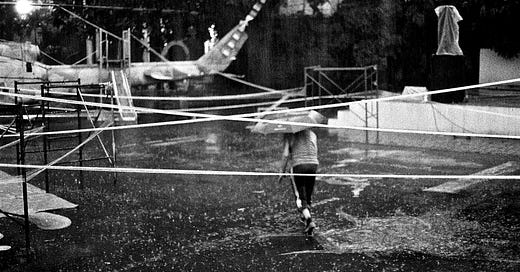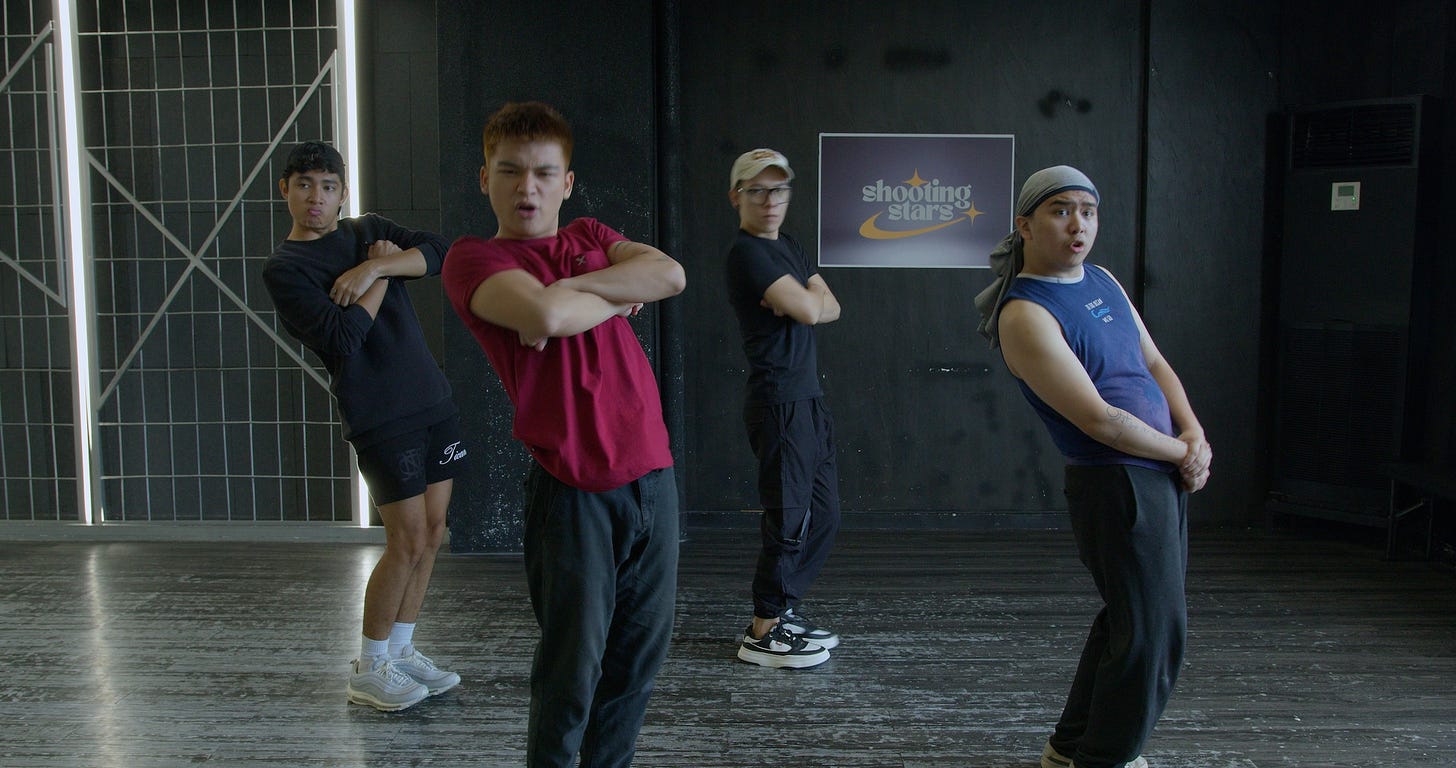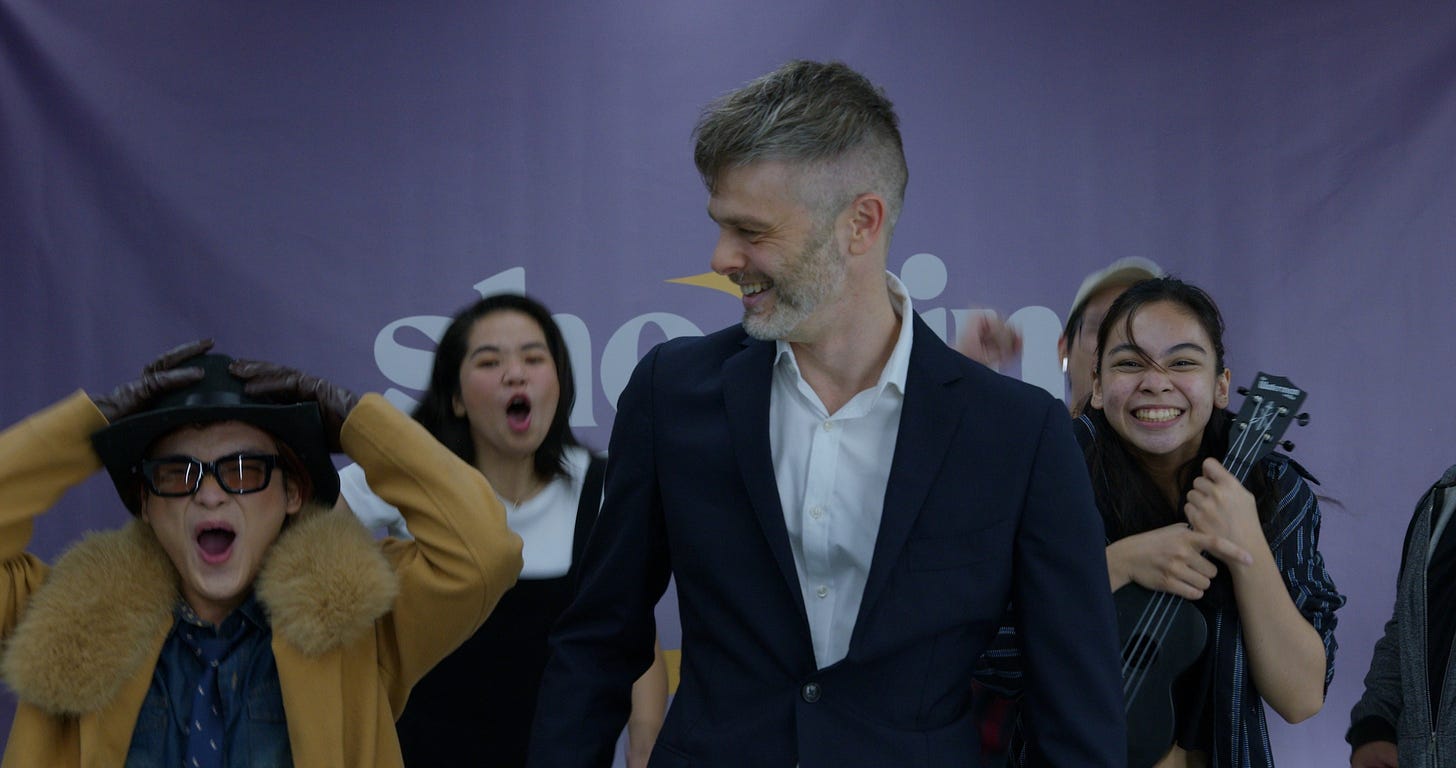2025-2030: Emerging themes in the climate space
The stories we'll tell about climate in the second half of this decade
For a podcast version of this newsletter, you can listen on Spotify or in your browser.
—————————————
Climate moves fast.
Stories and artworks about the climate go from cutting edge to dated, almost as quickly as they’re produced. Even in theatre, which is comparatively responsive (compared with novels and films), climate works have a very short shelflife. I’ve seen my mid-2010s play Kill Climate Deniers go from ‘ahead of its time’ to ‘of its time’ to ‘nostalgic’ to ‘museum piece’ in the span of a few years.
The recent wave of books and films about eco-activism (Tim Winton’s Juice, Daniel Goldhaber’s How To Blow Up A Pipeline, Jane Shearer’s Threads of Connection) feel like they’re responding to a moment in the late 2010s and early 2020s - the rise of Extinction Rebellion and the school strikes, the emergence of Just Stop Oil, disruptive protests at sports and theatre events, SUVs ‘disabled’ with lentils in the tyre pin - that feels like it’s already passing.
Being dated doesn’t mean a story is dull, or not worth telling. I loved How To Blow Up A Pipeline, and the dramatic questions raised by disruptive eco-activism are timeless. I’ll keep reading (and writing) stories about eco-activists, I find them fascinating. But as we enter the second half of the decade, the climate landscape looks very different than it did in 2021 or 2022, and I’m not sure that stories about soup thrown at oil paintings have the same urgent currency that they did.
So what are the new themes and threads in the climate space?
In this post, I want to sketch out four of the emerging themes I see developing in the climate conversation. These are subjects that I’d love to see artists and storytellers engaging with over the next 3-5 years.
1. Geoengineering / Climate solutions
Years ago, Jonathan Foley of Drawdown made the comment that instead of focusing on climate action vs climate denial, we need more stories about competing solutions.
When climate change was a distant smudge on the horizon, it was possible to talk about ‘climate action’ as a single thing, a thing it would be good for us to do. But now the wave has broken over our head, and climate change has fractured all around us into a million different facets, impacting us in different ways and interacting to create new complex challenges. The problems are everywhere, but that means so are the solutions. And we are now thoroughly in the process of building the new world.
Geoengineering, particularly solar radiation management or stratospheric aerosol injection, is now thoroughly part of the cultural discourse. Kim Stanley Robinson and Neal Stephenson both published blockbuster sci-fi novels in which SRM is a major plot point. But there are other forms of climate solution at play which raise equally challenging ethical dilemmas. Seabed curtains to stop warm water from seeping into glacier beds in Antarctica and Greenland. Crispr genome editing to eliminate invasive species or to re-colour species entirely. Electrifying entire rivers.
These speculative solutions are not science fiction, they are already being developed and tested in the world right now, and the communities cohering around them (and in opposition to them) are rich sources of story.
Less speculative and high-tech, but perhaps even more important is the friction around installing new renewable energy infrastructure.
We’re all aware, I think, of the unbelievable explosion in renewable energy technology since 2010, how solar and wind have exceeded all possible expectations for what they might produce. But I think many artists and writers have yet to really dive into the world of climate solutions to see what’s happening where these technologies are being implemented. Building new solar and wind facilities, upgrading or replacing cables; all of this requires land.
Communities have responded to this repurposing of land in very different ways. There are clashes over where and how to build this new infrastructure, and those clashes are cutting across political lines in unexpected ways. I tagged along when my partner Rebecca was doing some research on native animal rehabilitation in North Queensland, and heard hardcore environmental activists arguing bitterly against new transmission lines for renewable energy facilities because they cut across nature corridors for vulnerable species.
We are in the early stages of re-engineering our entire energy system, and when it comes to using land, we’ve already used a lot of the low-hanging fruit. The coming years will see extraordinary struggles and debates over whose land is used for what purpose, and none of these debates have easy answers. I want stories about these debates, these complex fractures and negotiations.
2. The New Denial
Climate denial has had a fascinating and twisting path. In the 1970s, it was entirely reasonably to be skeptical of the bold claims being made by climate modellers. Skepticism is scientific, and climate skeptics were a completely legitimate part of the scientific landscape.
As the evidence for global warming accumulated over the 80s and 90s, skepticism retreated to the scientific fringe, then vanished from the science world altogether. Climate denial moved from science journals to newspaper editorial pages, then to the world of blogs, then to the comments section of those blogs. At each phase, the claims of deniers were less scientifically credible, and more shrill and desperate.
The natural assumption among climate scientists and commentators (including myself) was that this kind of hard denial would ultimately wither and die. In the 2010s, many people predicted we would see climate denial replaced by ‘eco-fascism’, a right-wing ideology which acknowledges the threat of climate change, but which uses it as an excuse for increased border security and militarisation rather than international treaties.
That hasn’t happened. In the 2020s, climate denial is stronger than ever before. Instead of withering away in the face of escalating extreme weather, climate denial has instead become a foundational part of right-wing politics.
Still, as increasing droughts, floods, storms, heatwaves and fires have become unignorable, denial has mutated once again, this time into a kind of conspiratorial thinking. Climate deniers now acknowledge that, yes, the weather is changing - but not because of fossil fuel emissions. Instead, the cause of the problem is ‘them’.
That ‘them’ is ever-changing. In the case of wildfires, ‘they’ are arsonists - members of Antifa, migrant communities or even climate activists, deliberately lighting fires to try to prove that climate change is real. In the case of droughts, ‘they’ are wealthy tech billionaires carrying out secret climate geoengineering projects. In the case of storms and floods (according to the guy I met outside a supermarket in Vermont), ‘they’ are the United Nations manipulating the weather to force people out of rural communities and into 15 Minute Cities where they can be monitored and controlled.
It’s now clear that there is no threshold event where people will ‘accept’ that climate change is happening as the result of greenhouse gas emissions. Instead, as massive transformations upset every part of the biosphere, explanations will proliferate and blame will be apportioned in all kinds of directions. If attacks on scientific institutions are successful enough, climate denial might prove to be more robust than climate science.
That’s a world that I don’t think anyone predicted, and I’d be fascinated to see stories and artworks that engage with this reality.
Climate adaptation specialist (and my brother) Chris Finnigan adds:
Another aspect of this trend worth noting is the inversion of class politics, with climate action now framed as 'elite'. For decades, climate activists saw themselves as representing the lower/working class base, who are subjected to the decisions of fossil fuel giants and their lobbyists. Activists also represented the marginalised nations against the ruling Western powers.
The last decade has seen this dynamic flip around. Climate action is described as an elite concern. Renewable projects, not fossil fuel giants, are now considered to threaten the fabric of rural communities. People in wealthier areas also tend to be more supportive of climate action, whereas people in outer suburban electorates or poorer countries tend to rank climate as a much lower priority.
One could go even further and note many people tend to feel the climate transition is being imposed on them - embedded in a set of correct habits and lifestyle choices - rather than something that they would benefit from. Owning EVs is seen less as a commitment to climate justice than as a demonstration of wealth. Even grassroots actions like Extinction Rebellion or Just Stop Oil are described as elite-coded.
This is a weird place for the Left to be in. We see ourselves as pushing against powerful elites, yet we are pigeon-holed as hectoring hall monitors and language police. How can art engage with this reality?
3. Triage
One of Alex Steffen’s key markers for whether a government is meaningfully preparing for climate change is: They are acknowledging what they can’t save.
In the climate era, nowhere is safe. Every community is vulnerable to its own unique risk vectors. Floods, heatwaves, fires, water supply, energy, supply chain shocks… All these risks compound in complex unpredictable ways, and even areas that seem secure can be hammered by unexpected confluences of crises.
But there are some places that are more exposed than others, and in many cities it’s already easy to see which districts and suburbs will be uninhabitable in a few decades.
Sooner or later, everywhere will be faced with the question: What do you protect, and what do you abandon? The more resources you expend trying to save everything, the fewer resources you have to support and resettle the people who ultimately have to move. The more money we spend subsidising insurance for vulnerable oceanside communities, the less money we have to rehome those people when the sea inevitably claims them anyway.
Unfortunately, it is absolutely anathema for a politician to tell people that their homes might be beyond saving. The blowback against any government who dares to talk about triage will be swift and brutal. So instead we’re sleepwalking clearly into the worst of both worlds, where we spend our resources trying to preserve doomed infrastructure and communities, instead of spending them on more viable long-term solutions.
The conversation about what to abandon, when to abandon it, and how to negotiate the accompanying pain and grief will be one of the defining experiences of the coming generation. I want more stories that dig into this.
Chris adds:
At an ontological level, this is arguably a manifestation of the modern idea that we can control, extract from and direct the natural environment to serve our societal purposes. Nature being subject to our agency, as distinct from traditional knowledge ontologies where our agency is subject to natural cycles.
Calls for more sea walls or more backburning (or, at a more extreme level, that the Weather Bureau is deliberately causing cyclones) reflect this sense we still have authority over the environment. Art has arguably approached this through the genre of disaster movies (e.g. Day After Tomorrow) where everything bad happens at once very dramatically.
Is there artistic value in considering the slow/incremental relinquishment of control over the environment? If done well, work like this could create the social license/buy-in that leads to a step-change in Climate Adaptation and Resilience policy-making.
4. China as Protagonist
The story of international climate negotiations charts a distinct arc. In the 1970s and 80s, climate change was a matter for the US and Europe to grapple with. No-one else had the scientific expertise to see the issue clearly, let alone the resources to address it. While climate scientists tried to communicate the severity of the issue, industry lobbyists tried to mask or downplay the issue.
In the 1990s and 2000s, climate negotiations became a source of friction between rich and developing countries. Global South countries pointed out that Global North countries caused the problem, and demanded that they fix it, and pay for the damages.
Even in the mid-2020s, most climate politics stories adopt the frame of climate activists vs greedy corporations, or about vulnerable countries shaming rich countries. But in the last 15 years, this dynamic has shifted massively. As China has become both the world’s biggest emitter and the biggest hub of climate action on the planet, it has taken ownership of the climate issue.
China is building the infrastructure and systems that are needed to survive the 21st century. If we get through this crisis in any kind of good shape, it will be because of China’s actions. If climate is the story of the 21st century, then at its heart, it’s a story about China’s efforts to lift its population out of poverty without fundamentally destabilising our shared biosphere.
This is not a way of saying that the Chinese government are heroes - speaking personally, I don’t think I’d be very happy in a future world led by the CCP. But if the protagonist of a story is the character who changes the most, who creates change in their path, then in political terms, the protagonist of the climate story is China. And I want to see more stories that get to grips with that.
—
These are just some of the conversations and debates in the climate space that have emerged in the last few years that feel to me, in some way or another, wholly new. To varying degrees they were all predictable (and predicted), but they are manifesting in unexpected ways as the currents and tides of social forces run together in the rapids of history.
There are already rich discussions as climate journalists, scholars and commentators grapple with them - but I’m excited for artists and writers to condense these issues from abstract phenomenon into human stories.
——
POSTSCRIPT: If you’re aware of stories - plays, TV shows, books, films - that are already exploring these issues and telling these stories, please let me know.
—————
NEWS AND PROJECTS
Shooting Stars
This is an exciting one. After a few years of development, this lunatic project is finally going live. Myself, writer Sam Burns-Warr and film-maker Brandon Relucio are collaborating with Manila theatre company Mahiwaga Street (Adrienne Vergara and Siglo) to present Shooting Stars, our immersive P-pop competition.
Here’s the breakdown from the website:
20 contestants. One high pressure contest. Victory is everything.
Shooting Stars is the Philippines’ newest pop music talent show. Over one month, 20 young contestants will face off in a series of challenges. The winners will be assembled into a new P-pop group: The Shooting Stars.
Shooting Stars is an ‘unreality TV show’, a unique mix of live theatre, scripted drama and interactive virtual performance.
The season unfolds over May 2025 through weekly Youtube episodes, social media livestreams and live performances. At the end, the audience themselves will decide the final winners, the contestants who will become the Shooting Stars.
Experience the backstage dramas, the love affairs, the rivalries, the betrayals, and above all, the music, in this no-holds-barred ride into the dark heart of P-pop.
Scenes from the Climate Era tour
I’m also delighted to announce that Belvoir Theatre will be taking their production of Scenes from the Climate Era on tour around regional Australia this May and June. Stoked that Carissa Licciardello’s amazing work will be journeying out into the world and landing in regional venues - check out the touring schedule and please get along if you’re nearby.
—————
RECOMMENDATIONS
Hattie Crisell - In Writing
A curated selection of interview quotes about the practice and lifestyle of writing, compiled in themed chapters with short essays by Crisell. I loved the hell out of this, and it landed at just the right time for me. Highly recommended for all creative souls.
Bambinodj - Silent Dispatch EP
I am hooked on this EP. It’s so simple, but so perfectly composed, and I’ve fallen in love with it, like a warm hug on a cold day.
---
As ever, you can get more background on my practice in my New Rules for Modelling series, or you can check out my website. And if you have any questions or offers that might make my life more interesting, feel free to get in touch.
Peace!








